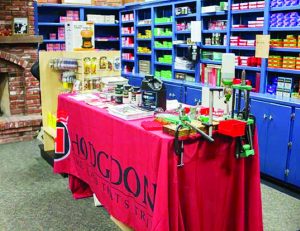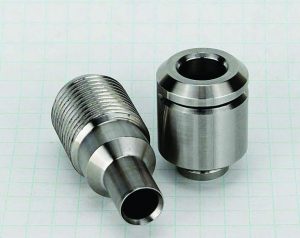By Art Merrill | Contributing Editor
Do you know someone interested in getting started handloading? Some youths, perhaps? Are you still just reading about it and thinking, “Maybe someday…?” Then get down to your local gun shop and ask the proprietor to contact Hodgdon forthwith, because “someday” has arrived. Among all the interesting things to come out of SHOT Show 2019, Hodgdon announced the company is reviving its 1960s Reloading Roadshow to teach newbies an introduction to the art and craft of rolling their own ammo.
“Grandad started this concept over 50 years ago, personally traveling around the country to show consumers how to reload,” Chris Hodgdon said in a press release. “I think he would be proud to see his family and his company keeping this tradition alive.”
Hodgdon is partnering with Dillon Precision, Frankford Arsenal, Hornady, Lee Precision, Lyman, MEC, Nosler, RCBS, Redding, Sierra Bullets and Speer to coordinate with your local gun shop to provide an expert instructor to teach an introductory class in handloading metallic cartridges or shot shells. All you have to bring is your interest; the instructor and the companies above will provide tools and components, and students will receive a hat and a reloading guide/data booklet to take home – along with a brain refreshed with new knowledge and confidence.
Check the Hodgdon website (www.hodgdon.com) or Facebook channel to see when a Reloading Roadshow is coming to your town. Or, be an instigator—visit your local gun shop and get the show on the road by having the shop contact Hodgdon for how-to information. Carpe diem!
“Best” vs “Good enough”
Before I say this next bit, I will repeat what I said in a past article here: I have no brand loyalty. I own reloading dies and tools from every major manufacturer, as well as from the small guys, fly-by-nights and others no longer in business.
I teach a monthly handloading class for a local gun shop. In discussing reloading tools with a prospective student, he blurted, “But my friend said don’t buy Lee ‘cuz it’s cheap stuff.”

You can bring Hodgdon’s Reloading Roadshow to your town. (Photo courtesy Hodgdon)
This is a misconception I hear occasionally, and in my experience it is as untrue as all other blanket statements. Lee Precision is perhaps suffering the curse of underselling their competitors, prompting the misperception that, because Lee is the least expensive, it must be low quality. Allow me to argue that with a few illustrations.
Some years ago I bought an old “club rifle.” These rifles hail from the 1950s-1960s; used by European gun clubs for competition, they’re built on Mauser 98 actions and fitted with match grade barrels and triggers. Mine is from Denmark, chambered in 6.5x55mm. I loaded ammo using the standard Lee dies I already had on hand and I took my Dane to the next 600-yard match just for fun and to show it off to interested competitors. In perusing my data book, I see that the rifle put a respectable seven rounds into the X ring that day, its very first outing with a first, just-git-er-done-to-shoot-the-match handload.
I had previously used those same Lee dies to load for my Swedish M38 Mauser, with which I’ve won club Vintage Military Rifle matches fired at 100 yards. And using Lee 8x57mm dies, one of my sporterized milsurp deer/elk rifles (with original military barrel) puts 200-gr. Nosler Partitions into .93” at 100 yards. I’ve demonstrated to my satisfaction that Lee dies are equal to anyone else’s standard dies if precision ammunition is our standard of measure.
If I were to change anything about Lee dies, I would add a set screw to the locking rings—a small complaint resolved by purchasing or scrounging said locking rings. Lee dies get an undeserved bad rap from people who simply repeat the opinions of others who may or may not have had real experience with them. I have both decades of experience and the hard data of recorded results. And, as I said, no brand loyalty!
It’s not a perfect world, and every manufacturer’s QA department has inadvertently let a lemon slip by; yet one bad sample does not accurately reflect the true quality of a product. Every manufacturer thinks he’s made the better mousetrap, and you may prefer one maker’s die or tool features and disdain those of another’s. Fair enough! You may be attracted or repelled by aesthetics of appearance, packaging or advertising—or the opinions of others—that has no bearing on actual tool performance. Unrealistic, but also your prerogative!

We’ll be working with another new tool from the folks at 22 Reloader, a DIY gas-check punch.
In many of its tools, Lee Precision utilizes aluminum, plastic or other non-steel parts, a significant cost-saving measure that they pass on to the buyer. Certainly, we want the highest quality, best-engineered tools we can buy, and most of us, being gear heads, appreciate the skill and finesse that goes into finely machined, polished, hardened steel tools boasting nano-tight tolerances. But that comes at a price sometimes more than we can afford—and more than we really need to accomplish a task. You could buy a hammer machined from a single block of stainless steel, but a forged hammer head fixed to a wooden handle drives nails equally as well and at a fraction of the cost—and the latter can be well-made and durable for what it is.
That said, sometimes highest quality is the only way to go. Measuring tools are one area not to skimp, because we need precise, consistent measurements to create precise, consistent ammunition. Plastic, soft metals and cheap manufacturing have no place among calipers, micrometers, bullet comparators, runout gauges and the like.
The tradeoff in handloading tools is the same as in everything else we buy: spending more usually means we get more—but not always, and we don’t always need more. Good enough is just that—good enough. Very often the extra money we spend on products (of any kind) only pays for slick advertising that suggests an image of ourselves that appeals to our ego. That said, it is often true that the more expensive tools really do outperform the less expensive ones. About the only way to know for sure is through personal experience.
A 1¢ gas check?
Brian Nixon, who brought us the Percussion Cap Maker, 22LR Reloader, 22WMR Reloader and Prime-All for mixing our own priming material, brought to SHOT Show 2019 a clever new tool for the bullet caster, a punch for DIY gas checks.
The punch is in two parts, both mounting to your single stage reloading press. The cutting portion threads into the top of your press, the punch snaps into the ram like a shell holder. The punch forms gas checks from ordinary roofing flashing (like that installed around pipes and chimneys) that you can find in many hardware stores.
“Gas checks are getting up there in price,” Brian said. “They’re—what?—about five cents apiece now. With this tool you can make ’em for maybe a penny each, or less.”
OK, maybe it’s hard to get excited about a few pennies, but saving four cents per gas check means the tool eventually pays for itself, especially for the volume bullet caster. And the hefty tool is a one-time purchase, made of machined stainless steel to last several lifetimes—no surprise, as Brian collaborated with Robin Sharpless at Redding Reloading Equipment in designing the tool.
I intend to work with the gas check punch this year and present you an evaluation. Plus, it occurs to me that some flashing is made of galvanized steel, galvanizing being essentially a zinc coating, which opens a whole new door in the handloading/bullet casting exploration. “So, what’s the big deal about zinc?” you ask. Ah, that’s another story…



